Petition Background: Powys Chicken Sheds – Maps, Graphs and Stats, Principal Environmental Considerations
Introduction
CPRW’s Brecon & Radnor and Montgomery Branches are increasingly concerned, as are other local environmental NGOs, at the proliferation of intensive poultry units (IPUs) across Powys. The rapid development of this industry in the county in recent years (to 2018) is illustrated in the animated map below. The date of each annual “snapshot” is shown in the lower right corner.
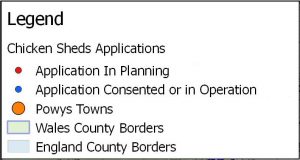
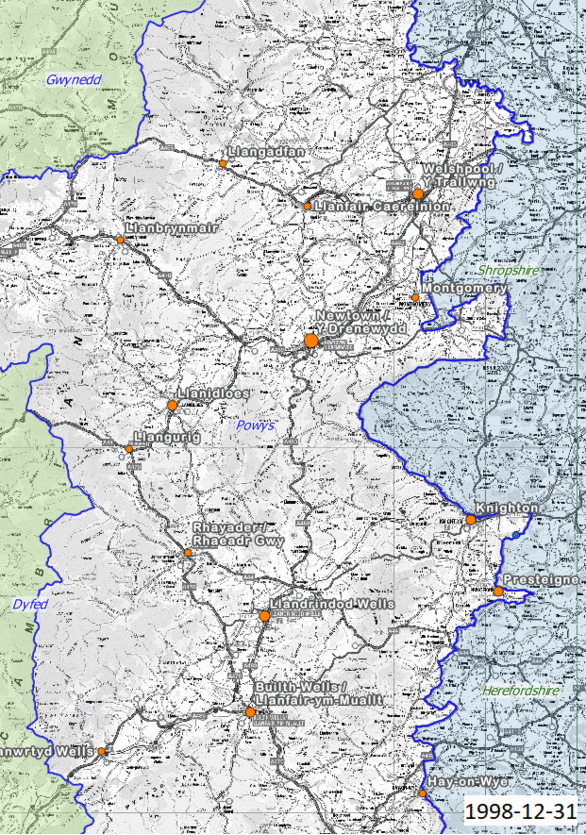
The following map shows both the In Planning and Consented Applications that we are aware of as at 30 June 2018. It is based on the same data as our interactive map on this page (although the data on that page is more recent – as at 22nd August 2022). We have collated all data on applications since July 2015. During this time applications for a further 116 poultry units have been submitted, only two of which has been refused. Approval of all these applications (up to end June 2018) would bring the total number of chickens applied for in Powys to 7.7 million.
And, as at 20th November 2020 the total number of chickens applied for in Powys is over 10 million, with around 1.2 million of these currently In Planning.

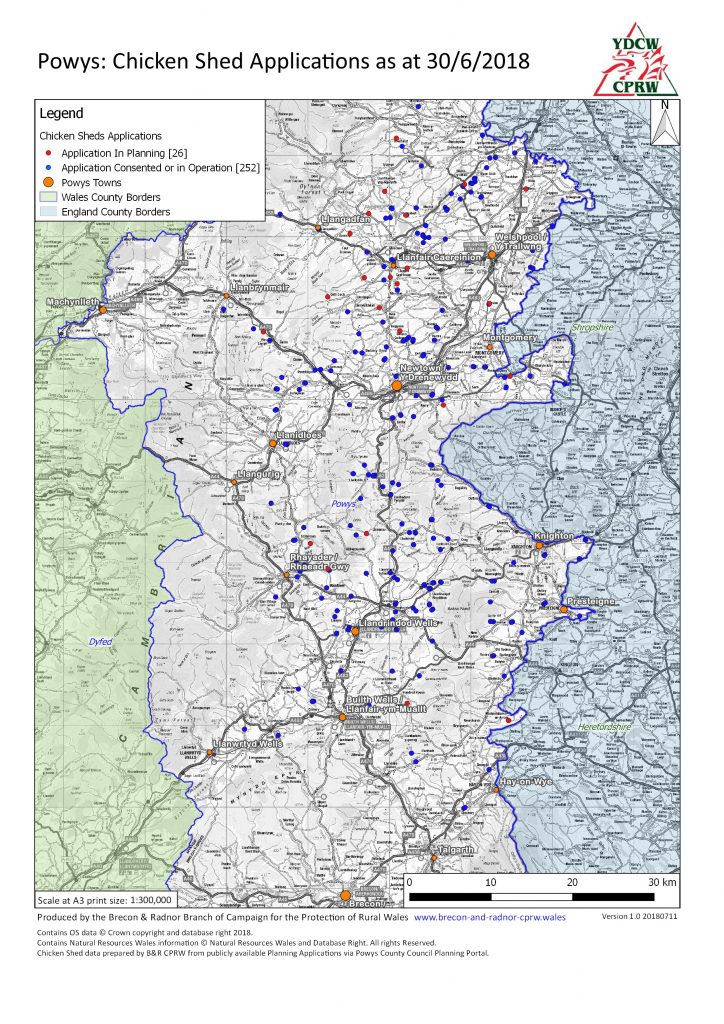
At the end of June 2018 around 7.7 million birds are housed at any one time in IPUs on nearly 200 farms* and new planning applications for IPUs are received on an almost weekly basis. At the end of January 2019 comparative figures are 8.2 million birds on just over 200 farms. Powys, together with neighbouring English counties, has one of the highest densities of IPUs in Europe. The following graphs illustrate a) the total number of chickens on applications is increasing year on year, and b) the cumulative totals of chickens year on year is rising at an increasing rate. (*These figures include some IPUs still in the planning system and awaiting determination.)
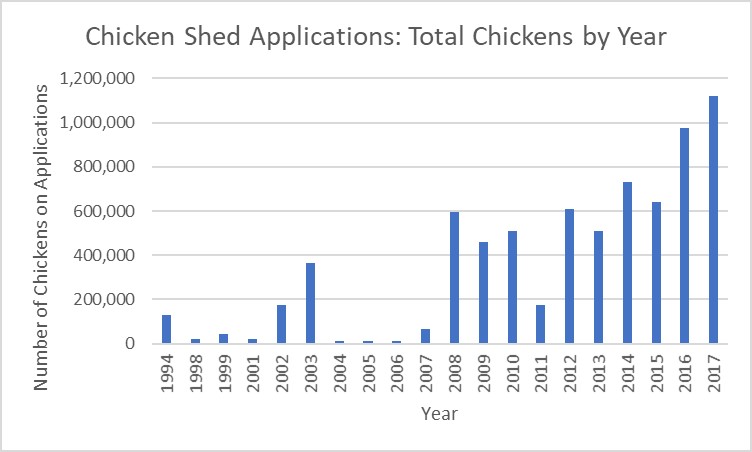

Principal Environmental Considerations
In recognition of the huge potential for pollution and other environmental impacts, the Town and Country Planning (Environmental Impact Assessment) Regulations 2011 places IPUs housing more than 85,000 broilers or 60,000 hens in the same category of development as oil refineries and airports. All developments housing over 40,000 birds require an environmental permit from Natural Resources Wales (NRW). Unfortunately, impacts are not restricted to the larger developments.
This year NRW’s 2015 Powys Poultry Pilot Study was published. This study highlights the potential for smaller unregulated free range egg units to have a greater environmental impact than larger regulated intensive units, and emphasises the need for very careful assessment of impacts of planning proposals before further planning permissions are given.
In spite of this, intensive poultry developments are classified as ‘farm diversification’ and are permitted in open countryside where their impacts are potentially greatest.
The map below illustrates the areas of greatest concentrations of intensively-raised poultry across Powys and their proximity to Powys’ towns, villages and hamlets.
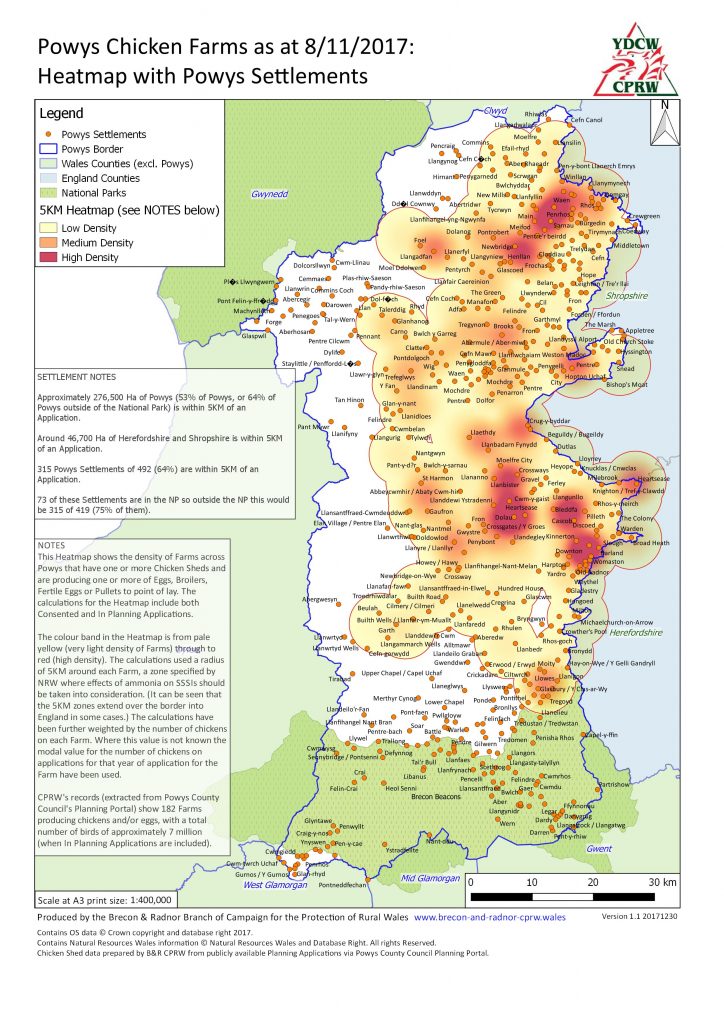
Landscape
IPU sheds are typically around 100m long by 20m wide and, with accompanying hard standing, silos and supporting infrastructure, are hard to assimilate into intricate and small scale landscapes. We consider that this is given inadequate consideration in the determination of applications. The county’s landscapes underpin the tourist industry, which is of vital economic importance.
Air Quality
IPUs emit ammonia and poultry dust, and generate large amounts of traffic on otherwise quiet rural roads.
Ammonia deposition significantly contributes to the nitrogen enrichment of our ecosystems, fatal to many of our rarer plants. The urgency of tackling this “elephant in the room of nature conservation” is set out in Plantlife’s recent publication “We Need To Talk About Nitrogen (Wales)”. Excess nitrogen and phosphorus impacts on ecosystems have been identified, together with biodiversity loss, as the most urgent and critical exceedances of planetary boundaries.
In recognition of this significant pollution source and the risks posed by the poultry industry, NRW have recently published the following documents (which replace previous guidance GN41 and Quick Guide 9):
- Guidance Note 20: Assessing the impact of ammonia and nitrogen on designated sites from new and expanding intensive livestock units sets out detail on the methodology for the assessment of impacts on ammonia emissions and nitrogen deposition from intensive livestock units on designated sites and is intended primarily for use by applicants, NRW and Local Planning Authorities.
- Guidance Note 21: Poultry units: planning permission and environmental assessment provides a checklist of minimum information required to support a planning application and further information on management plans, design etc.
Poultry dust
Poultry dust is categorised as a “substance hazardous to human health” by the Health and Safety Executive (HSE), and is linked with respiratory complaints and with potential for permanent lung damage – see the HSE’s “Quick Guide to Poultry Dust”.
Traffic
IPUs create significant extra traffic associated with egg and bird collection, deliveries of birds, feed deliveries, cleaning, daily visits to monitor birds and collect carcases, manure removal and general management of the site. The number, size and weight of vehicles may be unsuitable for small country roads, creating safety and amenity issues for other road users and residents.
Water Quality
Poultry manure has the highest concentration of nitrogen, phosphorus, and potassium of all animal manures. Clearly a valuable fertiliser, poultry manure is also a potent pollution risk if inappropriately stored, spread, or transported. See ‘Poultry Manure Management’ Technical Article, Farming Connect. Water contamination may also arise as a result of run off from outdoor ranges and hardstanding, shed washing, soil erosion and contaminated waters from shed roofs.
The growth in the industry has coincided with a rise in phosphate levels in several of the county’s rivers, including the Wye, Lugg and Ithon.
See Wales Environment Link ‘Position Statement – Restoring our Freshwaters: pollution from land management’, which calls for a moratorium on further intensive livestock development in Wales whilst research into in-combination impacts of development to date on water and air quality is undertaken.
Farm Diversification
We clearly understand the need for farm diversification, and appreciate that small family farms are currently facing great uncertainty, exacerbated by Brexit. However, IPUs pose a very real threat to the county’s landscapes, ecosystems and to the tourist industry. We will continue to campaign for appropriate support to be offered to farmers to ensure the future of the county’s small farms.
Our data demonstrates that there is a steadily increasing rate of applications being received and approved. The cumulative impacts of the scale of development already in place have received no proper analysis and need urgent investigation, in accordance with Environment (Wales) Act 2016 Part 1 Section 4 Principles of Sustainable Management of Natural Resources, particularly subsection (e).
Data Source
Data is extracted from Powys Planning Portal Weekly Application Lists which have been tracked since 2011. IPUs before this date may not appear on the map, and developments which remain unbuilt or have been discontinued may still be shown on the map. We have prepared these maps and statistics in good faith. Please notify us of any errors or omissions.
[Revised September 2022]
